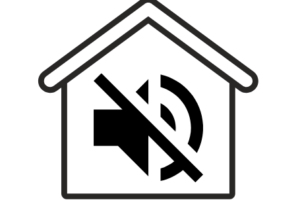If you’ve been talking to a professional or even researching on your own about soundproofing a wall or a ceiling, you would’ve come across the term: resilient channel
So, what is a resilient channel?
A resilient channel is a metal bar that is used to ensure that the drywall and wood framing inside the wall(called studwork) don’t touch, as the drywall is screwed onto the channel instead of the stud. This ensures that sound vibrations have a harder time travelling through the wall, which makes it more soundproof. Let’s look into how this works in detail.
Types of resilient channels and what are they made of?
There are mainly two types of resilient channels- and they are commonly called RC1 and RC2.
RC1 is a single legged resilient channel while RC2 is two legged.
Talking about soundproofing benefits, a RC1 channel is slightly better. This is because a RC1 channel, owing to the fact that it has just one leg, has lesser surface area in contact with the wooden stud it is screwed on. This in turn, means that there is a lesser chance of sound vibrations travelling through the studs.
Still, the difference in sound isolation benefits provided by a RC1 channel Vs RC2 channels is quite minimal, and nothing too significant. Moreover, RC2 channels, because they have 2 legs, can handle more mass. If you’re considering adding having two drywall layers with a resilient channel in between, your contractor is probably going to recommend a RC2 resilient channel over RC1.
So, mainly due to the fact that the soundproofing benefit are similar to RC1, but it can handle more mass, is why RC2 is more commonly used. In fact, most contractors, when talking about resilient channels are usually, referring to a RC2 resilient channel.
The underlying principle of soundproofing through resilient channel
Sound travels through any medium by causing the particles in that medium to vibrate. Now, it’s another matter how effectively that happens, as some media are more ‘excitable’ than others- but that being said, unless there is a vaccum, like in space, sound finds a way to travel.
Through air, wood, drywall- the same principle of vibration allows sound to travel. So then what is so special about a resilient channel that isolates the walls from sound vibrations?
In a word- decoupling.
Decoupling means taking two materials that are in direct contact with each other, and placing them in indirect contact. In the context of soundproofing, this is done by placing a non-conducting material between them.
Let’s take an example:
In walls where a resilient channel isn’t used, the drywall is drilled directly on to the wooden frames or studs. This allows sound vibrations an easy path to travel through, since both the wood studs and drywall are conducting materials for sound.
However:
If, instead of being drilled directly on the studs, the drywall is drilled onto the resilient channel, it isolates the drywall and studs effectively and brings a reduction in noise transmission.
Another benefit of decoupling is that it creates an air gap inside the wall. Air is a good insulator and is beneficial for soundproofing.
Having said that, there are two problems with decoupling as a method of soundproofing:
- It eats away at room space, since you’re thickening the walls by adding air gaps.
- It needs to be done correctly, as the air gaps have their own resonance, and might resonate with the sound frequency travelling through them. The exact frequency of resonance depends on factors like the gap dimensions- something your contractor will have to calculate and account for
How effective are resilient channels?
Resilient channels can add about 3-5 STC points overall.
FYI- STC is a measure of effectiveness of a material for soundproofing. Read more about it here.
3-5 STC points won’t really make any significant change, which is why your contractor will recommend a few other soundproofing techniques to use in tandem.
There are a couple of other techniques, that could be explored such as:
- Staggered stud formation
- Adding a layer of drywall
- Adding mass through MLV
- Using a damping compound
Optimally speaking, the best way to soundproof using resilient channels, that will also suit most people’s needs, seems to be along with a extra layer of drywall and some green glue(a damping compound- read more about it here)
The best estimate I could find on the internet was that you can get about a 15-17 STC point boost by doing this.
The big issue with resilient channels
Resilient channels have no industry standard specifications yet, as they are not specified by Steel Stud Manufacturers Association(SSMA). This means there are a lot of inferior quality products in the market(in fact- there apparently have even been lawsuits over this!).
Unless your contractor knows of a reputable resilient channel brand and has used it previously with success, I wouldn’t recommend using a resilient channel.
Installing a resilient channel can be tricky as well, and if not done correctly, can lead to the short circuiting of the connection between drywall and studs.
On the flip side, the big plus of using a resilient channel over it’s alternatives is that it’s cheap. However, if you ask me, it’s worth it to spend a little more and have the peace of mind that you’re installing a high quality product.
So, let’s look at the alternatives and see how effective they can be at soundproofing
Alternatives to resilient channel?
Sound clips
These are probably the best alternative to resilient channel. In fact, when used along with furring channels, they’ll give a STC boost of 15-17 points.
Coming on to performance, they provide better sound insulation than resilient channels, and are better non-conductors of sound.
You attach sound clips on to the studs and they’ll usually also have a rubber component to isolate the sound further.
Hat/Furring channels
Hat channels are used a lot by masons to level out uneven ceilings- which is where the name furring channel also comes from. ‘Furr’ means ‘to raise’.
Hat channels mainly consist of two sizes- ⅞” and 1-½”.
Since they raise the level in order to get an even surface, a hat channel also will decouple the drywall from the stud, which is why it’s also used in soundproofing applications.
You’ll find that most resilient furring strips/hat channels are pre punched and can be easily screwed onto the existing studwork.
While you get wooden furring channels as well, generally, metal furring channels are preferred as they are more resistant to heat and the environment.
Conclusion
A furring channel and sound clips used in tandem will provide a greater degree of soundproofing to you. However, there is no absolute rule here it depends on your situation and the amount of isolation you need.
Another thing I want to point out is that in soundproofing, it’s all about the details. After a soundproofing project, you might realize there’s a small space around ONE electrical outlet in the wall and you’ll be right where you started.
So, it’s important to look at things holistically- rather than in isolation, when it comes to soundproofing. At the end of the day, a resilient channel or a sound clip is just a tactic for soundproofing a wall.
FAQ
Should you install a resilient channel for all types of walls?
No, only for drywall
Can you install resilient channel over existing drywall?
Yes- by adding another layer of drywall over it.
Resilient channel on both sides of the wall or just one?
There’s no harm in adding resilient channels on both sides, but usually, there’s no need of doing so.
How far apart should you mount resilient channels?
The answer is.. it depends. Generally, the more weight you’re putting on the channels, the closer to each other they should be


